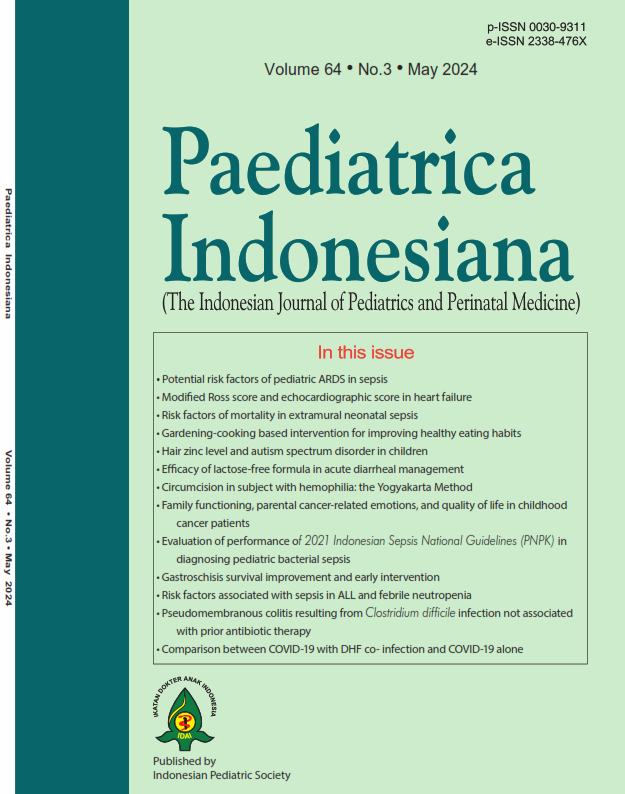Circumcision in subject with hemophilia: the Yogyakarta Method
DOI:
https://doi.org/10.14238/pi64.3.2024.244-9Keywords:
Circumcision, Hemophilia, Clotting factor concentrates, District hospitalAbstract
Background Circumcision is one of the most common surgical procedures in boys in Indonesia. In cases patient with hemophilia (PWH), doctors tend to avoid this procedure due to increased bleeding tendency. In 2007, we developed a protocol for clotting factor concentrate (CFC) administration for circumcision in SWH, namely, the “Yogyakarta Method.”
Objective To evaluate the outcomes of the Yogyakarta Method for circumcising PWH.
Methods This descriptive study was based on medical records of PWH who underwent circumcision at Dr. Sardjito Hospital (DSH), Yogyakarta and 3 surrounding hospitals under DSH supervision from 2008-2017 and 2018-2022. Diagnoses of hemophilia were based on clinical findings and factor assays. Subjects with hemophilia A received factor VIII (25 IU/kg/dose) and those with hemophilia B received factor IX (50 IU/kg/dose) before, during and after the procedure. In addition, patients received tranexamic acid (15 mg/kg/dose). Circumcision was performed by a pediatric surgeon or urologist.
Results From 2008-2017, 28 PWH underwent circumcision, 14/28 of whom were in DSH. Twenty-six patients had hemophilia A and 2 had hemophilia B. Their severities were mild (12 subjects), moderate (10), and severe (6). Subjects’ median age was 10.5 (5-19) years and their median CFC use was 8 (range 7-10) doses in hemophilia A and 4 (range 4-5) doses in hemophilia B patients. Three of 28 PWH had bleeding episodes after the procedure. Following the encouraging results from the initial 2008-2017 study period, most of PWH circumcised in 2018-2022 underwent the procedure in the same 3 district hospitals rather than at DSH (21/28 subjects), and had similar CFC consumption. Only 1 bleeding episode occurred after the procedure during the second study period.
Conclusion The Yogyakarta method is safe and sufficient to control bleeding in circumcision of PWH. This method is also suitable in a district hospital setting.
References
2. ?ahin F, Beyazova U, Aktürk A. Attitudes and practices regarding circumcision in Turkey. Child Care Health Dev. 2003;29:275-80. DOI: https://doi.org/10.1046/j.1365-2214.2003.00342.x
3. WHO, UNAIDS. Male circumcision: global trends and determinants of prevalence, safety and acceptability. [cite 2024.04.24]. Available from: https://data.unaids.org/pub/report/2007/jc1360_male_circumcision_en.pdf
4. Kavakli K, Kurugöl Z, Göksen D, Nisli G. Should hemophiliac patients be circumcised? Pediatr Hematol Oncol. 2000;17:149-53. DOI: https://doi.org/10.1080/088800100276505
5. Rodriguez V, Titapiwatanakun R, Moir C, Schmidt KA, Pruthi RK. To circumcise or not to circumcise? Circumcision in patients with bleeding disorders. Haemophilia. 2010;16:272-6. DOI: https://doi.org/10.1111/j.1365-2516.2009.02119.x
6. Kumar R, Carcao M. Inherited Abnormalities of Coagulation: Hemophilia, von Willebrand Disease, and Beyond. Pediatr Clin North Amer. 2013;60:1419-41. DOI: https://doi.org/10.1016/j.pcl.2013.09.002
7. Weiss HA, Larke N, Halperin D, Schenker I. Complications of circumcision in male neonates, infants and children: a systematic review. BMC Urol. 2010;10:2-15. DOI: https://doi.org/10.1186/1471-2490-10-2
8. Srivastava A, Santagostino E, Dougall A, Kitchen S, Sutherland M, Pipe SW, et al. WFH guidelines for the management of hemophilia, 3rd edition. Haemophilia. 2020;26:1-158. DOI: https://doi.org/10.1111/hae.14046
9. Widjajanto PH, Sugiarti R, Sutaryo S, Ali K. Circumcision in boys with mild Hemophilia A – the Yogyakarta experience. Paediatr Indones. 2007;47:71-3. DOI:
https://doi.org/10.14238/pi47.2.2007.71-3
10. Karita D, Romdhoni MF. Hubungan usia dan berat badan dengan ukuran lingkar penis anak menggunakan O-meter: sirkumsisi Metode Klem. Herb-Medicine 2018;1. DOI: https://doi.org/10.30595/hmj.v1i1.2479
11. Zulifikar B, Karaman M, Ovali F. Circumcision in haemophilia an overview. [cited 2024.04.24]. Available from: http://www.wfh.org/2/docs/Publications/Diagnosis_and_Treatment/TOH-30_English_Circumcision.pdf.
12. Elalfy MS, Elbarbary NS, Eldebeiky MS, El Danasoury AS. Risk of bleeding and inhibitor development after circumcision of previously untreated or minimally treated severe hemophilia A children. Pediatr Hematol Oncol. 2012;29:485-93. DOI: https://doi.org/10.3109/08880018.2012.704624
13. Seck M, Sagna A, Guéye MS, Faye BF, Sy D, Touré SA, et al. Circumcision in hemophilia using low quantity of factor concentrates: experience from Dakar, Senegal. BMC Hematol. 2017;17:8-14. DOI: https://doi.org/10.1186/s12878-017-0080-1
14. Karaman MI, Zulfikar B, Caskurlu T, Ergenekon E. Circumcision in hemophilia: a cost-effective method using a novel device. J Pediatr Surg. 2004;39:1562-4. DOI: https://doi.org/10.1016/j.jpedsurg.2004.06.025
15. Bawazir OA, Alharbi I. Circumcision in hemophilia: a multicenter experience. J Pediatr Hematol Oncol. 2021;43:e33-6. DOI:
https://doi.org/10.1097/MPH.0000000000001960
Downloads
Published
How to Cite
Issue
Section
License
Authors who publish with this journal agree to the following terms:
Authors retain copyright and grant the journal right of first publication with the work simultaneously licensed under a Creative Commons Attribution License that allows others to share the work with an acknowledgement of the work's authorship and initial publication in this journal.
Authors are able to enter into separate, additional contractual arrangements for the non-exclusive distribution of the journal's published version of the work (e.g., post it to an institutional repository or publish it in a book), with an acknowledgement of its initial publication in this journal.
Accepted 2024-05-30
Published 2024-05-30













